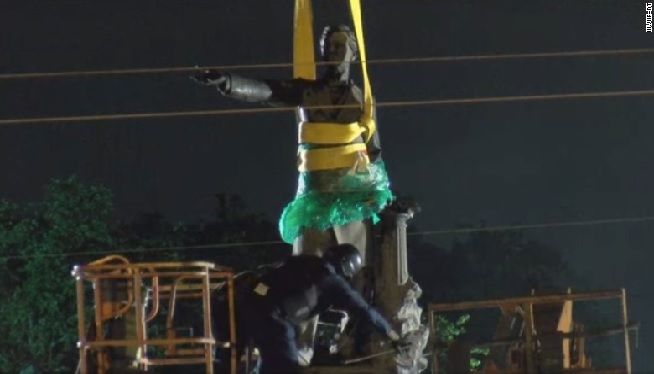NEW ORLEANS — (CNN) Under heavy police presence, crews began to take down the statue of former Confederate President Jefferson Davis in New Orleans early Thursday morning.
It’s the second Confederate monument to come down after the New Orleans city council voted to remove four such landmarks back in 2015. After years of heated public debate and legal battles, recent court decisions paved the way for the city to relocate the four monuments.
Early Thursday, pro-monument supporters held vigil at the Davis statue and hoisted Confederate flags.
People who want to see the monuments removed also gathered at the site and cheered at the sight of heavy trucks and a crane moving into place. They chanted, “Take ’em down” and “White supremacy’s got to go.”
The opposing sides screamed insults and threats at one another as police separated them using barriers.
The statues in New Orleans are part of a controversy surrounding Confederate symbols over whether they represent slavery and racial injustice, or heritage. The issue became especially prominent after the massacre of nine black parishioners in a Charleston, South Carolina, by a self-described white supremacist in 2015.
“These monuments have stood not as historic or educational markers of our legacy of slavery and segregation, but in celebration of it,” said New Orleans Mayor Mitch Landrieu in a statement.
“To literally put the Confederacy on a pedestal in some of our most prominent public places is not only an inaccurate reflection of our past, it is an affront to our present, and a bad prescription for our future. We should not be afraid to confront and reconcile our past.”
Jefferson Davis in New Orleans
The Davis statue stands on top of a roughly 12-foot column and depicts the Confederate president with his right arm outstretched, towering over the street also named after him.
Davis lived in New Orleans after the Civil War and died there in 1889. The statue was dedicated in 1911.
In 2004, the words “slave owner” were painted on the base of the monument.
How they’re extracting the statue
Police had cordoned off the 6-foot tall bronze statue of Davis with a chain-link fence to keep protesters out.
Workers wore helmets as well as what appeared to be tactical vests and face masks. Cardboard boxes and tape covered the name of the contractors involved in the controversial operation — just like they had during the first Confederate landmark removal on April 24.
Near 4 a.m. local time, two workers approached the Davis statue in a work lift and wrapped it partially in green plastic.
They tied the statue’s torso with what appeared to be a long yellow banding, securing it to a crane. One of the workers dislodged the statue’s feet from the base using a long flat tool.
Meanwhile, other workers were grinding at the statue’s base with heavy machinery.
Two statues remain scheduled for removal
Last month, the city dismantled the first of its four scheduled monuments — an obelisk commemorating the Battle of Liberty Place. The monument marked a deadly fight between members of the “Crescent City White League,” a group opposed to the city’s biracial police force and state militia after the Civil War.
Two additional monuments in the city of Confederate generals Robert E. Lee and Pierre Gustave Toutant Beauregard are also scheduled for relocation.
Landrieu’s office has not revealed when these two remaining statues will come down, citing safety concerns.
The mayor’s office said the city has secured private funding to remove the monuments. Landrieu said the statues will go to storage while the city looks for a suitable place to display them, such as a museum.
The-CNN-Wire ™ & © 2017 Cable News Network, Inc., a Time Warner Company. All rights reserved. (PHOTO: WVUE-TV via CNN)





















